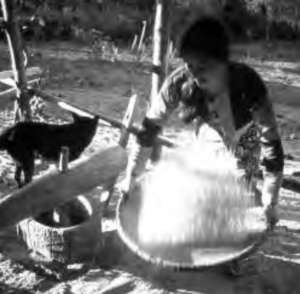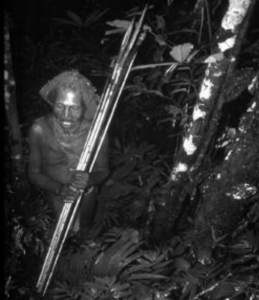INTRODUCTION
The ongoing struggle to procure the latest technology in our classrooms and the globalization of our curricula are two omnipresent themes in American education today. Many believe they are interdependent in that our World Wide Web, CD ROM, and other electronic connections are prerequisite to linking multiculturalism across the curriculum.
While few people, including this author, downplay the benefits of electronic learning, even the best interactive multimedia limit students to visual and auditory sensory perception. Conversely, the integration of “old technology” such as Malaysian blowguns, Tibetan cymbals, Tamil incense, and other material culture can enliven classroom presentations and effectively integrate into the curricula such core geographic themes as place, diffusion, and human-environment relationships. As Cart found when teaching about Jainism in India, “using material culture improves the study of religion.”1

Photo by Stephen Cunha.
As technology grows more pervasive while consuming shrinking budgets, we should not forget the “hands on” and “boot wet” pedagogy that has served geographers since antiquity. We can maximize both our funding and our results by balancing commercial multimedia acquisitions with material culture and kodachrome slides obtained in the field. Adding large format cartography creates a dynamic presentation that appeals to the whole student through multisensory, spatial, and technological avenues.
This paper will discuss techniques for building a material culture portfolio for educators who travel as part of their professional growth strategy. This requires a “research for teaching” commitment that includes predeparture goals, the careful selection and acquisition of artifacts, and prudent return shipping.
MATERIAL CULTURE AND GEOGRAPHIC THEMES
Material culture consists of physical and visible objects used by different societies to accomplish everyday tasks. This includes everything from barns, autos, and horse carts, to textiles, weaponry, cooking utensils, and jewelry, among others (although we focus on small artifacts that can be transported home). These items comprise the “built environment” integral to the cultural landscape that every society creates.2
Although cultural groups also produce obscure and rare items, their scarcity is less desirable for classroom use. When used in cultural context, artifacts provide insights into how humans use natural resources, their level of technology, gender relationships, and their objects of worship.3 Their regional origins reflect human-environment interaction, the diffusion and modification of ideas, and other attributes relevant to completing everyday tasks.
For example, the author’s plastic water jug from industrialized Singapore takes the form of a yak bladder in Tibet, a goat skin in the Indus River Plain, a clay pot in Bangalore, an empty coconut in New Guinea, and a discarded Clorox bottle in a Jakarta shantytown. The yak and goat containers reflect the strong reliance on animal husbandry found in Tibet and Pakistan. Although herding is also very important in southern India, the clay pots derive from a soil not found in the two other locations. In contrast, despite abundant clay and a meager number of domestic animals, isolated New Guinea highlanders opt for the convenience of empty coconut shells. Finally, the higher wage structure allows many Singapore residents to indulge in the “throw-away” penchant of developed economies. The disposable water bottles, along with other containers (Clorox bottles, jelly jars, milk jugs, etc.) are scavenged by shantytown dwellers from Singapore, Jakarta, Calcutta, and other Asian cities.
Similarly, the rifle toted by Pamirian shepherds (treeless sheep habitat) becomes a blowgun in the Malaysian rainforest (an efficient and silent killer of monkeys and birds), a self-bow in Irian Jaya (where blowguns are absent), and a bamboo snare in northern Thailand (where many snares are the most efficient hunting strategy in this more populated forest). Each weapon is designed for the specific environment, dietary preference and hunting strategy.
Clothing also imparts a sense of place as people everywhere dress according to various climatic, social, religious, gender, and financial parameters. Heavy wool skirts insulate Nepalese Sherpa women from a cold mountain climate. The loose fitting Pakistani burka suits both the Islamic code and a hot summer climate. Irian Jayan women produce grass skirts that reflect the available resources, climate demands, and paucity of contact with outsiders.
These endless possibilities share common traits:
- They are everyday items with counterparts in America (weaponry, containers, clothing)
- Their regional characteristics can be plotted on maps
- They illustrate and enliven discussion about core geographic themes (e.g., cultural ecology, diffusion, regionalism, and landscape)
- They can be systematically collected in the field at reasonable expense
- They are multisensory teaching aids that students remember
RESEARCH FOR TEACHING
Travel within Asia enriches teaching about Asia. Of the many benefits accrued abroad—insights, anecdotes, slides—collecting material culture is often the most underutilized. Too many educators return home with great wall hangings, but little to share with students.
Once home, we can use material culture to build indigenous “skills.” Students of all ages who learn to winnow, pound grain, set a snare, toss joss sticks, and prepare tea over a dung fire remember the multi-sensory experience and more willingly partake in class discussions. While we can’t take all of our students abroad, we can put key pieces of Asia in their hands. Collecting for classroom use entails different objectives than procuring for museums or scholarly research. The goal is to find items that complement your specific teaching unit, and illustrate for students the principal geographic themes.
This demands research before, during, and after travel to ensure the veracity of both your observations and acquisitions. Be aware that individual artifacts do not explain and predict the evolution of every culture, and that we must present them in context with the specific region and society from which they were collected.
Before departing, identify the curricular units (geography, history, environmental studies) and geographic themes (environment, culture, place) that make up your curriculum, then target these for collection. Your artifacts should also meet at least one of the guidelines listed in Table 1 and discussed below. The most effective objects appeal to multiple senses (texture, sound, odor, sight). They are hardy to withstand years of hands-on student use. They also illustrate more than one geographic theme (Table 2).
For example, a rare Tibetan silk brocade is a valuable museum piece or wall hanging, but the common wool aprons worn throughout Eastern Turkestan are better for classroom use. A generation of students can handle the rough yak wool while inhaling rancid butter and milk. Adding a saddle bag, wooden spoon, prespun wool, some dung (collected locally) and prayer flags will transport students to the roof of the world.
The material culture will enrich and stimulate discussion of pastoralism (human-environment interaction), the multiple uses of animals (food, fiber, dung, labor, status), the tradition of “ethnic dress” (place), and the contrast with our own textiles and lifeway (regions).
Similarly, the subtle “swish” of darts exiting Malaysian blowguns, combined with their abrupt “thud” on impact, illustrates the proficiency of this weapon on rainforest broad conical hats ubiquitous in Asian rice fields reveals how they protect wearers from the high angle tropical sun. For a real back breaker, have students harvest the local weed patch with Indian sickles (found in markets), then analyze labor use between the developed and developing world.
Common everyday items are often most useful because they contrast with our own objects. Eating utensils (Mongol bone spoons, Chinese porcelain ladles, Philippine bamboo knives, Indonesian coconut ladles), incense and religious icons (prayer wheels, joss sticks, prayer mats, ceremonial masks) all stimulate the eyes, ears, and tactile senses, and are associated with specific geographic factors. We find them throughout Asia and in the ethnic stores of many American cities.
One final consideration is how to focus your collection. Casting a “wide net” is one approach, but those with limited budget and luggage space should collect similar items from each region (such as spoons, hats, farm tools, wind instruments) along thematic tiles). Applying artifacts to relevant themes promotes hands-on analysis of the regional diversity within Asia.

Photo by Stephen Cunha.
LOCATING ARTIFACTS
Procuring material culture is easy. In general, the more common an object is abroad, the easier it is to find, and the more central role it occupies in Asian society. Mass produced farm implements, clothing, and religious icons are ubiquitous. Hand produced winnow baskets, textiles, clay pottery and the like are available in markets throughout Asia and in the artifact shops of most big cities. The variety and pricing is much better than at home, where import bazaar markups often exceed 1,000 percent for everyday pieces.
Be aware that mass tourism, even in the most remote locations, is changing some material culture as select items are produced more for tourists than for indigenous use. Simpson warns that artifacts can be simplified in the rush to exchange “culture for capital.”4 Hunting spears that compact into sections and the reproduction of locally obsolete stone tools are illustrative. This is more likely with art work produced for show back home (masks and carvings), than with less glamorous items such as harvesting tools, traps, and containers. Thorough research levitates accuracy, and despite mutation for tourists or shipping ease, these items are often still viable for teaching about Asia if you understand the modifications.
Collecting from both urban and rural Asians yields rich returns in accompanying anecdotes, slides, and site-specific data. The well trod tourist routes through Nepal, northern Thailand, and Bali are rich with opportunity to trade or buy everyday material culture. In these locations, look for impromptu markets offering jewelry and other art. At your suggestion, these entrepreneurs will often barter their everyday items for cash, pocket knives, and sunglasses.
A caveat applies when querying in this mode: the more isolated and less visited the settlement, the more sensitive we must be when soliciting material culture. Maintain respect and patience with everyone, and do not accept outright gifts, as it is custom in some societies to honor an outsider’s entreaty regardless of personal wealth. Buy the items that meet your educational criteria, and resist the urge to wait for something better as you may be able to barter, sell, or use both pieces. Finally, at first opportunity, write notes on each artifact while the conditions surrounding collection are still fresh in your mind.
FROM FIELD TO CLASSROOM
The journey from Asian village to American classroom has damaged more than one artifact. This is another reason to select sturdy items. Some Asian postal services are also unreliable. Often accrued purchases become heavy and unwieldy, thus increasing the breakage risk. When this occurs, the global express firms (DHL, FedEx, UPS) located throughout Asia are the most reliable way to return ship, although the cost may exceed the price of your purchases. Protecting awkward and oversized items can require some imagination and special packaging (Table 3).
Some items also fall under government antiquities protection; thus, export is illegal or may require special fees. Ethnic art procured in remote villages is illustrative. Perusing art and museum shops in large cities at the start of your trip is a good way to gauge restrictions. Asian governments seldom tax or prohibit everyday items.
Once home, your material culture will spark student interest, but on its own does not necessarily impart geographic information. This task falls on the instructor, who must present artifacts in context with geographic themes. These include but are not limited to: location, places and regions, human-environment interaction, mobility (diffusion), globalization and development, and cultural integration. These are discussed in “Geography for Life” and “Guidelines for Geographic Education.”5
Apart from the skill session and multisensory benefits mentioned above, there are infinite ways to integrate material culture into your teaching. Ask students to locate artifacts on a map, and then explain why they are suitable for that region (e.g., clothing with climate and culture; farm implements with environment, dietary preference, and development; religious icons with cultural-historical diffusion). Students may then “carry” (diffusion/mobility) the same items across Asia, analyzing their usefulness in regions of different environment, culture, and politics.
Linking cognate items throughout Asia and across the Pacific is another tangible way to emphasize the role development and technology play in our global economy. A collection of music cassettes, Pepsi cans, and computer diskettes—variously lettered in Japanese, Chinese, Vietnamese, Thai, Arabic, and English script—is one example. The opportunities derive from your own travels, artifact portfolio, teaching units, and thematic emphasis.

Photo by Stephen Cunha.
CONCLUSION
Liberal yet systematic use of material culture in the classroom and lecture hall can raise a flat map to life. However, everyday items from Asia achieve maximum benefit when deployed by the peripatetic teacher who collects and integrates them with geographic themes. As we move deeper into Information Age education, we need to make each dollar count.
Amidst mountains of new hardware and software should come tangible, odorous, noisy pieces of Asia that help students understand how people on the other side of the world meet the challenges of everyday living. This approach can help demonstrate how every group is sophisticated in its own right. There are still occasions when old technology in young hands is the most effective tool for educating about Asia.
NOTES
1. John E. Cart, “Art, Religion and Material Culture: Some Reflections on Method” Journal of American Academy of Religion 64:3, 1996.
2. Jerome Fellmann, Arthur Getis, and Judith Getis. Human Geography: Landscapes of Human Activities (Madison: Brown and Benchmark Publishers, 1997).
3. Albert Burgmann, “The Moral Significance of Material Culture.” Inquiry 35:3–4,1992; Ann S. Martin, “Material Things and Cultural Meanings: Notes on the Study of Early American Material Culture.” William and Mary Quarterly 53:5, 1996; and Meredith F. Small, “An Anthropologist’s Attic,” Scientific American 275:1, July 1996.
4. Bob Simpson, “Tourism and Tradition: From Healing to Heritage.” Annals of Tourism Research 20:164–81, 1993.
5. Geography Standards Education Project (GSEP). Geography For Life: National Geography Standards, 1994. Washington: National Geographic Research & Exploration, 1994; and Association of American Geographers and the National Council for Geographic Education (AAG/NCGE). “Guidelines for Geographic Education: Elementary and Secondary ” (Washington: Association of American Geographers and National Council for Geographic Education, 1984.)
OTHER RESOURCES
The World Wide Web is an excellent source of travel information. A few useful places to start include:
a). yahoo.com/Recreation/Travel provides a comprehensive listing of travel-related Web sites.
b). www.city.net provides data on many Asian cities.
c). www.state.gov is a U.S. State Department site that carries information on passports and government travel warnings.

